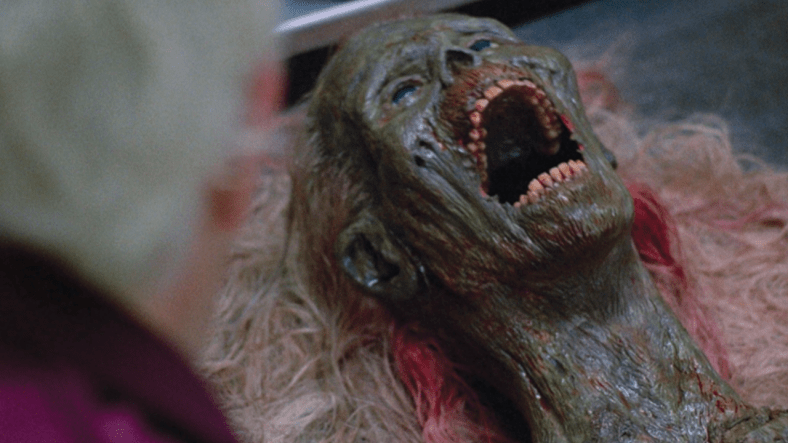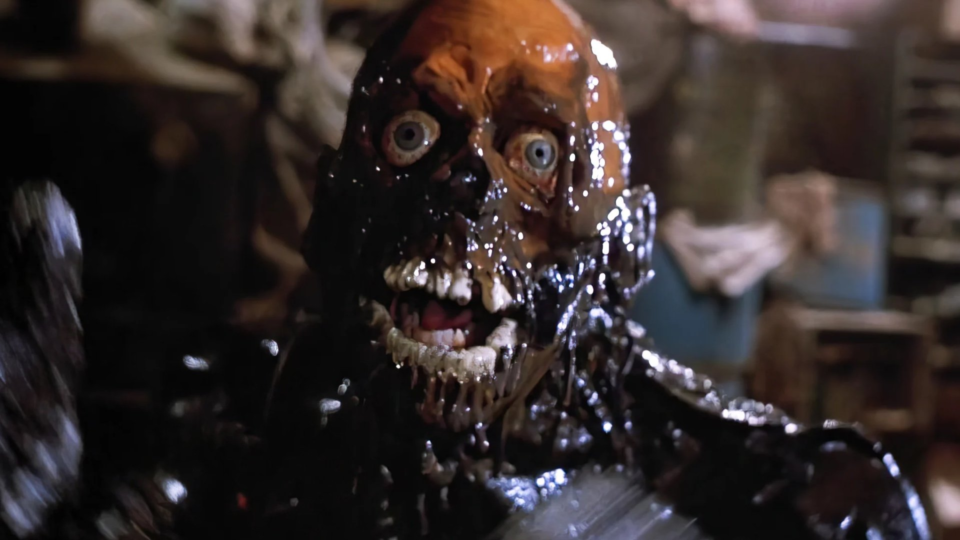‘The Return of the Living Dead’ is a Campy, Comical Depiction of ‘80s Punk Culture

The Return of the Living Dead (which observes a release date anniversary on August 16) is a film close to my heart. It marks the intersection of the horror genre and punk rock culture. It’s no secret that I’m a big fan of horror movies. Not to mention, I was raised on a steady diet of the anti-authoritarian musical stylings of yesteryear. So, the onscreen coupling of two of my greatest loves is bound to serve as a sweet spot for me. But I am certainly not alone in my adoration of Return of the Living Dead. In the years since its release, the film has gone on to spawn a series of sequels and become something of a cultural touchstone. With a campy sense of humor, thoughtful characterizations, and gratuitous amounts of carnage, it’s no surprise that people hold the flick in such high regard.
For a bit of context, the flick was born from creative differences between Night of the Living Dead co-creators John Russo and George Romero. The pair were unable to come to an agreement about where to take the Dead franchise. Eventually, a legal dispute ensued that gave the late George Romero the right to use Dead in the titles of his films and Russo was granted the right to use Living Dead. That led to Russo partnering with director Dan O’Bannon to bring Return of the Living Dead to life as a quasi-sequel to Night of the Living Dead. Return makes reference to its 1968 predecessor but labels the picture as a film based on actual events, rather than being a true precursor to Night of the Living Dead.
Also Read: Return of the Living Dead III is a Punk Rock Zombie Love Story for the Ages [The Overlook Motel]
Return of the Living Dead follows a pair of well-meaning employees at a medical supply warehouse. The staffers make the grave mistake of disturbing a drum filled with toxic gas. The mishap ultimately leads to a toxin being released into the air and raining down on a cemetery where a whole host of corpses are rejuvenated. The warehouse workers set out to fix their error and join forces with the owner of the warehouse, an undertaker, and a group of angsty punk rockers.
Like Night of the Living Dead before it, Return of the Living Dead is responsible for introducing commonly accepted zombie tropes into the cinematic pantheon. Specifically, the film is credited for the pivot from zombies merely seeking human flesh to looking for braiiiiins. Moreover, Return of the Living Dead is the first cinematic outing (to my knowledge) that makes its zombies impervious to a gunshot to the head.

The film is additionally noteworthy for featuring great characters across the board. James Karen is terrific as warehouse employee Frank. He serves as something of a mentor to his younger counterpart, Freddy (Thom Mathews). He spends his early scenes cracking jokes that would make your dad groan. But he’s undeniably charming. He responds to his own tired puns with a self-satisfied chuckle, making him come across as accessible and disarming.
Also Read: Why Edgar Wright Doesn’t Love ‘The Return of the Living Dead’
Clu Gulager is also a smart addition to the cast. He shines as Burt, the owner of the medical supply company, and has the scenery-chewing boss archetype down pat. In fact, he feels a little like a live-action version of Mr. Spacely from The Jetsons.
There are also some standouts among the teenage rebels. Linnea Quigley is unforgettable in her scene-stealing turn as Trash. Her graveyard dance sequence is among the most memorable scenes is a film filled with memorable setups.
Miguel A Nuñez Jr. is also great in his turn as Spider. The actor has expert comedic timing and imbues his character with a no-nonsense attitude that results in some hilarious exchanges with his costars.

The punk rock teens also serve as an aesthetically accurate representation of punk culture in the ‘80s. They speak in the slang of that era; they come outfitted in duds that make a statement; and their attitudes parallel the rebellious ideals of punk culture.
Also Read: Julie, Sweet Julie: Why Return of the Living Dead 3 Is One of the Most Inventive Sequels Ever
We had seen punk representation onscreen prior to Return of the Living Dead but many of those characterizations were reductive and existed as secondary or tertiary players. The punk characters in Return of the Living Dead have the chance to take center stage. And this time, those characters get to function as primary players, rather than supporting characters relegated to the background.
Ultimately, the film functions as a loose sequel to Night of the Living Dead but very much stands as its own entity. Return of the Living Dead is campy, comical, and frequently brutal. If you’re game for a rewatch in observance of the film’s anniversary, you are in luck. You can check it out for free (with ads) via Pluto and Tubi, as of the publication of this post.
Categorized:Editorials

